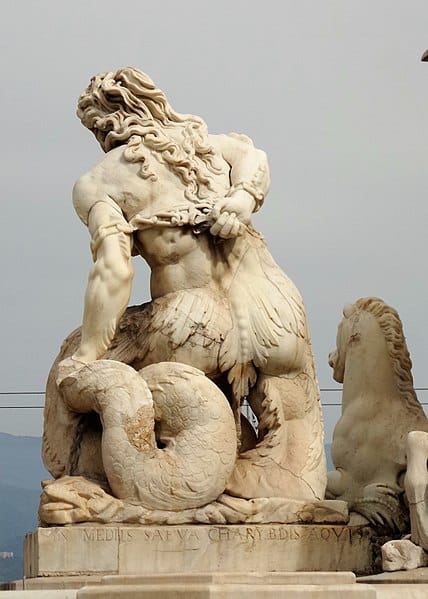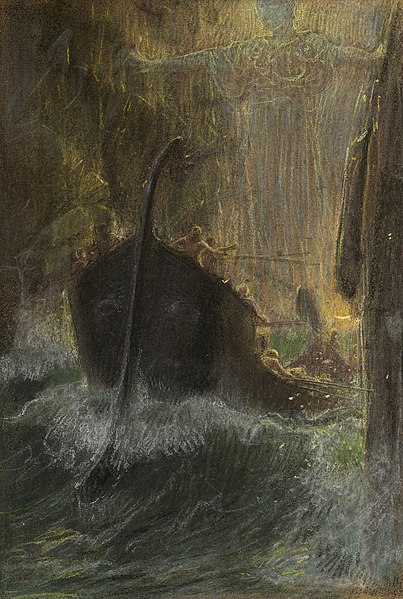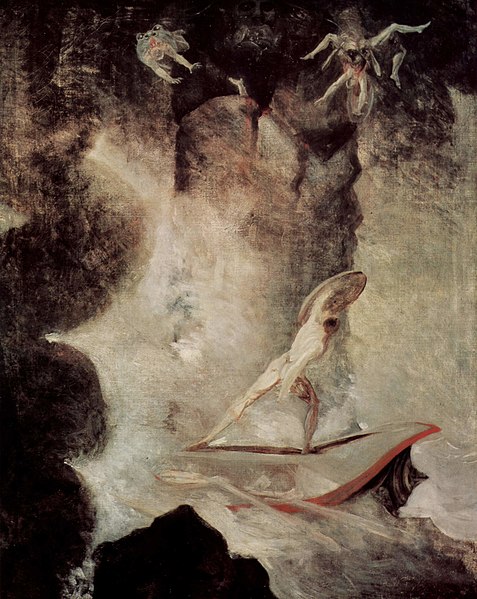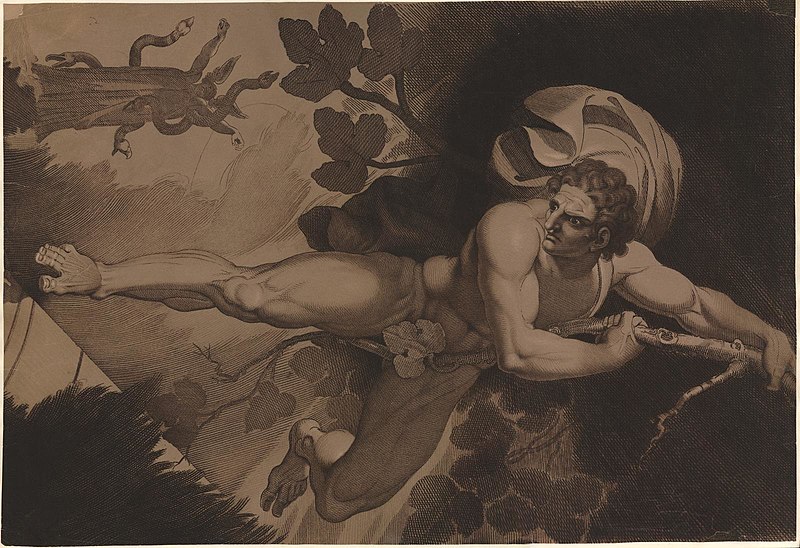In the vast tapestry of Greek mythology monsters, few are as unique and terrifying as Charybdis. Often paired with the monster Scylla, The Sea Monster of Ancient Lore, Charybdis is not a creature of fangs and claws but a massive, swirling whirlpool that threatens to drag sailors to a watery grave. This monstrous maelstrom, lurking in the waters of the Mediterranean, has been a symbol of nature’s uncontrollable power and the perils of the sea.
Charybdis Key Facts
| Origin | Cursed by Zeus |
| Creator | None |
| Defeated by | None (avoided by heroes) |
| Habitat | Straits of Messina |
| Other names | The Whirlpool |
| Roman name | Charybdis |
| Associated with | Scylla |
| Symbols | Whirlpool, swirling waters |
Name and Etymology
The name “Charybdis” has its roots in ancient Greek, derived from the word “χαρυβδίς” which can be translated to “gulp” or “suck down.” This is fitting, given her nature as a voracious whirlpool, always hungry and ready to swallow anything venturing too close. In Roman myths, her name remains unchanged, a testament to the lasting impact of her legend.
While Charybdis is her most recognized name, she’s often referred to simply as “The Whirlpool” in various tales. This epithet underscores her primary characteristic and the danger she poses to sailors. Unlike many other monsters in Greek mythology, Charybdis doesn’t have a plethora of names or titles. Instead, her singular, defining trait stands out, making her instantly recognizable in any myth.
Charybdis Origin and Creation
Charybdis was not always the monstrous whirlpool we know today. In some tales, she was a beautiful nymph and the daughter of Poseidon, The Olympian God of The Sea and Gaia, Greek Goddess and Mother of The Earth. She served her father loyally, helping him enlarge his watery domain by flooding lands with her vast waters. However, her actions angered Zeus, the king of the gods. As punishment for her transgressions, Zeus cursed her, transforming her into a monstrous whirlpool. She was forever doomed to swallow vast amounts of water and then release them, creating a hazard for any sailor unfortunate enough to be nearby.
This transformation from a divine being to a monstrous force of nature is a recurring theme in Greek mythology. It serves as a cautionary tale about the consequences of defying the gods and the fickle nature of divine favor. Charybdis, with her ceaseless hunger, became a symbol of nature’s uncontrollable power, a force even the gods could not tame.

Her existence, paired with Scylla, another sea monster, created a deadly challenge for sailors navigating the narrow Strait of Messina. This perilous passage, with Scylla on one side and Charybdis on the other, became a metaphorical representation of being caught between two dangers, a theme that resonates even in modern times.
Depiction And Characteristics

Charybdis, unlike many monsters of Greek myth, doesn’t have a humanoid or beastly form. Instead, she’s often depicted as a massive, swirling vortex, a whirlpool that threatens to pull everything nearby into its depths. Ancient pottery and mosaics showcase her as a circular maw, surrounded by treacherous waves. Often with ships and sailors helplessly caught in her pull.
Charybdis Appearance
The appearance of Charybdis is unique in the realm of Greek monsters. She lacks the fangs, claws, or grotesque features commonly associated with creatures of myth. Instead, her terror lies in her vast, swirling waters. Ancient depictions often portray her as a gaping maw in the sea, surrounded by tumultuous waves. Ships, broken apart by her force, can be seen being sucked into her depths. Furthermore emphasizing the doom that awaits those who venture too close.
Her portrayal serves as a stark reminder of the unpredictable and often perilous nature of the sea. Sailors of ancient Greece, reliant on the ocean for trade and travel, would have been all too familiar with the dangers of whirlpools and rough waters. Charybdis, in her relentless and insatiable hunger, embodies these dangers. Moreovere, she is serving as a symbol of the sea’s might and the perils that lurk beneath its surface.
Charybdis Nature and Behavior
Charybdis is relentless and predictable in her behavior. Three times a day, she would swallow vast amounts of water, creating a deadly whirlpool. Then, she would release these waters, causing tumultuous waves that could capsize any ship nearby. This cyclical nature made her a constant threat, a peril that sailors had to be ever wary of.
Unlike many monsters, Charybdis doesn’t act out of malice or hunger for flesh. Her actions are a result of her curse, a never-ending cycle of swallowing and regurgitating water. This lack of intent or malice makes her even more terrifying. She’s an unstoppable force of nature, indifferent to the lives she claims.
Charybdis Abilities
The primary ability of Charybdis lies in her power to create massive whirlpools. With her insatiable thirst, she can draw in vast amounts of water, along with any ship or sailor unfortunate enough to be nearby. This whirlpool, with its powerful currents, is nearly impossible to escape from, making Charybdis one of the most feared monsters of the sea.
Additionally, her ability to release these waters causes equally dangerous waves, capable of capsizing ships and drowning sailors. Her cyclical nature, the predictable pattern of swallowing and releasing water, is both a blessing and a curse. While it allows sailors to predict and potentially avoid her dangers, those caught unaware find themselves facing an unstoppable force of nature.
Charybdis Symbols or Associations
Charybdis, in her essence, is associated with whirlpools and the dangers of the sea. She serves as a symbol of nature’s unpredictability and the perils that come with it. In a broader sense, she, along with Scylla, represents the idea of being caught between two dangers. This concept, often referred to as “being between Scylla and Charybdis,” has become a common idiom, highlighting the challenges of navigating between two equally perilous options.
In terms of symbols, Charybdis is often represented by swirling waters or a gaping maw in the sea. These symbols, simple yet evocative, capture the essence of her nature and the doom she brings to those who venture too close.
Myths about Charybdis
Charybdis, with her ceaseless hunger and perilous waters, features prominently in several Greek myths. These tales, often intertwined with those of other monsters, showcase the challenges heroes faced when confronting her.
Odysseus and Charybdis
One of the most iconic encounters with Charybdis is detailed in Homer’s “Odyssey.” As Odysseus, The Cunning Hero Of The Trojan War and his crew navigate the perilous waters between Charybdis and Scylla, they face a dire choice. To avoid the whirlpool of Charybdis, they sail closer to Scylla, resulting in the loss of six of Odysseus’s men. Later, when they’re forced to pass by Charybdis again, the whirlpool swallows their ship, but Odysseus manages to survive by clinging to a fig tree. As Charybdis releases the water, the ship is expelled, and Odysseus continues his journey.
Jason and the Argonauts
While not as detailed as Odysseus’s encounter, the tale of Jason and the Argonauts also references the dangers of Charybdis. In their quest for the Golden Fleece, the Argonauts had to navigate the perilous waters where Charybdis and Scylla resided. Thanks to the guidance of Thetis, a sea nymph, and the other Nereids, the Argonauts were able to safely navigate past the whirlpool monster and her counterpart, Scylla. This tale emphasizes the importance of divine intervention and the challenges that even the most seasoned sailors faced when confronted with the likes of Charybdis.
Aeneas’s Journey
In Virgil’s “Aeneid,” the Trojan hero Aeneas also encounters the dangers of Charybdis as he journeys to Italy after the fall of Troy. While the focus is more on Scylla, the presence of Charybdis is palpable, serving as a constant threat to Aeneas, the Trojan hero and his crew. The tale underscores the idea that even the most heroic figures, favored by the gods, were not immune to the perils of the sea and the monsters that lurked within.

These encounters, each unique in its own right, showcase the omnipresent danger that Charybdis posed to sailors and the lengths to which heroes went to avoid her deadly embrace.
Representations Of Charybdis In Art
Charybdis, with her unique nature, has been a source of inspiration for artists throughout the ages. While her depictions in ancient art are limited, primarily due to her formless nature, she has been featured in various artworks in more recent times.
One notable representation is “Odysseus and Charybdis,” a painting by the French artist Auguste Couder, showcased at the Louvre Museum. This artwork captures the tension of the moment, with Odysseus and his crew navigating the treacherous waters, the whirlpool of Charybdis looming ominously in the background.
Another fascinating piece is “Scylla and Charybdis” by the British artist John Melhuish Strudwick. This painting, with its intricate details and dramatic composition, offers a unique interpretation of the two monsters and the challenges they pose to sailors.
Mentions in Ancient Texts
Charybdis, with her perilous waters, has been referenced in several ancient texts, each offering a unique perspective on this fearsome whirlpool.
Homer’s “Odyssey,” composed around the 8th century BCE, provides the most detailed account of Charybdis. In Book XII, Odysseus recounts his harrowing encounter with her, describing the whirlpool’s vastness and the challenges of navigating past her. A memorable line from this epic reads, “So we looked toward Charybdis, fearing destruction; but she, meanwhile, sucked down the salt water of the sea.”
Another mention of Charybdis can be found in the “Argonautica” by Apollonius Rhodius. This text, detailing the adventures of Jason, The Leader Of The Argonauts, briefly touches upon the dangers of Charybdis and Scylla, emphasizing the challenges sailors faced when navigating these perilous waters.
Furthermore, the Roman poet Virgil, in his “Aeneid,” alludes to Charybdis, using her as a metaphor for danger and the challenges of navigating between two perils.
Frequently Asked Questions
Charybdis is a unique sea monster, manifesting as a massive whirlpool that threatens to drag sailors to their doom.
She is said to lurk in the Straits of Messina. Often paired with another sea monster, Scylla, creating a perilous passage for sailors.
Charybdis was cursed by Zeus and transformed into a whirlpool as punishment for her actions servicing her father, Poseidon.
Charybdis swallows vast amounts of water and creates her whirlpool three times a day.
Unlike many monsters, Charybdis doesn’t act out of malice. Her actions are a result of her curse, making her an unstoppable force of nature.
The most famous encounter is with Odysseus, who managed to navigate past her dangers during his journey home.
Featured Image Credit: British Museum, CC BY-NC-SA 4.0, via Wikimedia Commons

